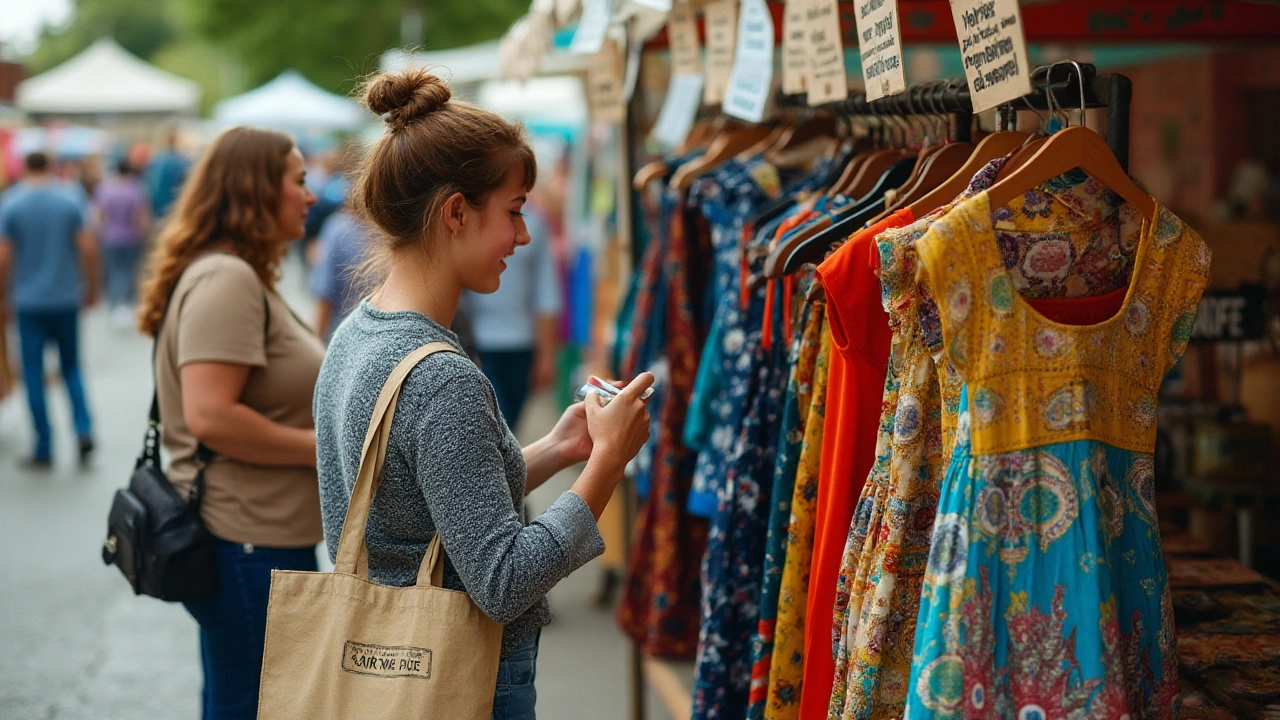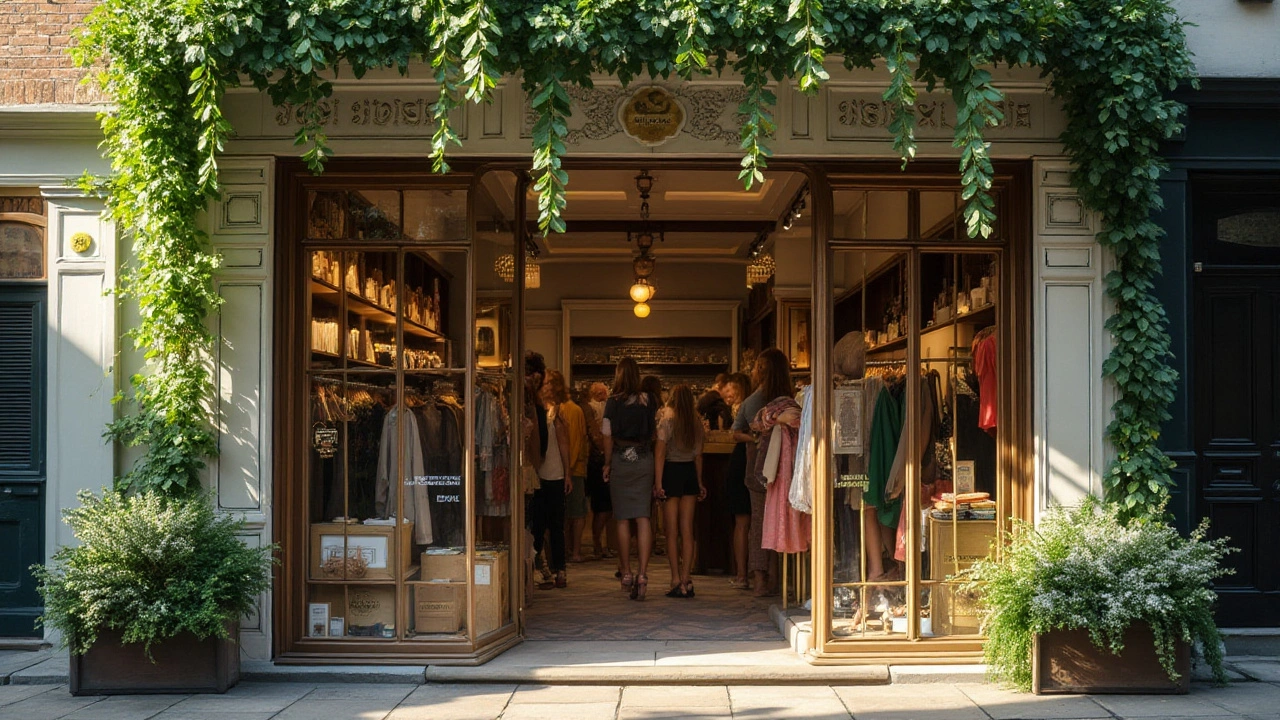Sustainability in fashion is much more than a passing trend; it's a commitment to preserving our planet while looking stylish. With plenty of brands claiming to be eco-friendly, how can you tell if they’re genuinely sustainable or just riding the green wave?
Delving into materials is a fantastic starting point. Sustainable brands often turn to organic cotton, bamboo, and recycled fibers. These aren’t just buzzwords; they significantly reduce environmental impact.
Of course, it's not just the fabrics that matter. A brand's production process tells an important part of the story. Ethical labor practices, waste management, and energy usage reveal a brand's true colors in terms of sustainability.
- Understanding Eco-Friendly Materials
- Examining Production Processes
- Transparency and Ethical Practices
- Certifications to Look Out For
- Aligning Brand Values with Personal Ethics
Understanding Eco-Friendly Materials
When we think of sustainable fashion, one of the first things that comes to mind is eco-friendly materials. But what exactly makes a fabric eco-friendly, and how can you tell if a brand is truly committed to sustainable practices? At the heart of eco-fashion are materials that are not just kind to the Earth, but also beneficial to the people who produce them. Brands dedicated to sustainability use natural fibers, like organic cotton, which is grown without harmful pesticides and requires significantly less water compared to conventional cotton. This means not only is the material itself safer for those who cultivate it, but it also helps in conserving valuable resources.
Bamboo is another popular choice amongst eco-friendly clothing producers. It's incredibly fast-growing and doesn't require replanting, making it a more renewable resource. Thanks to its rapid growth cycle, bamboo provides a steady supply of raw material without straining the environment. Additionally, it's biodegradable, which means that when it’s past its prime in your wardrobe, it can return to the earth without leaving a harmful trace. Recycled fibers, such as those derived from plastic bottles, are progressively being used as well. It’s a creative way of reducing waste, taking materials that would otherwise end up in a landfill, and transforming them into new garments.
Wool, particularly from sheep raised on organic farms, is prized for its durability and renewability. It's a fantastic insulator, keeping us warm during cold months, and does not require heavy washing like synthetic fibers. By choosing wool from farms that practice rotational grazing, you're supporting agriculture that sustains the soil and protects the landscape. Even tencel, a relatively new fabric made from sustainably sourced wood pulp, has joined the ranks of favored eco-materials. It’s silky smooth, breathable, and involves a low-impact production process, leading some experts to hail it as the fabric of the future. The Ellen MacArthur Foundation details how tencel’s closed-loop production method recycles water and solvents, keeping emissions low.
According to a report by The Sustainable Apparel Coalition, "The choice of material is the first step in building a garment with a low environmental footprint". Considering over 60% of a brand’s impact can come from this stage, the importance of choosing right materials cannot be overstated.
Factoring the True Cost of Materials
While selecting eco-friendly materials is a vital step, it is also crucial to weigh the true costs associated with them. This includes considering the energy intensity of processing these materials. Hemp, for instance, is incredibly robust and grows quickly with little water, but transforming it from plant to fabric requires more energy compared to others. Then there's linen, made from flax, a plant that not only enhances soil health but is entirely biodegradable. However, the wrinkle-prone nature of linen means additional care during its lifecycle, possibly resulting in more frequent ironing, thereby consuming energy over time. It’s a delicate balance, choosing materials that are friendly in their raw state but also manage their footprint throughout the life of a garment.For those wishing to make conscientious decisions, certifications such as GOTS (Global Organic Textile Standard) or OEKO-TEX provide assurance of quality and sustainability. They serve as markers that a brand's claims around eco-friendliness are credible and rigorously verified. Empowering yourself with this knowledge not only supports the planet but aligns your clothing choices with personal ethics, helping to carve out a new path forward in the realm of fashion.
Examining Production Processes
When we delve into the production processes of a sustainable fashion brand, the journey is as crucial as the destination, perhaps even more. Clothing production is an intricate dance of raw materials, labor, and technology, all interwoven to create the fabrics we drape ourselves in. A genuinely sustainable brand ensures every step aligns with the values of eco-friendly clothing and ethical responsibility. First off, manufacturers look to reduce or eliminate harmful chemicals. Traditional dyeing processes often involve toxic substances that can leach into waterways, affecting ecosystems and human health. Instead, eco-friendly companies turn to vegetable dyes or innovative digital printing techniques that use less water and are safer for the environment. It's about making sure that from the time a garment is dyed, it's not leaving behind a toxic legacy.
Labor is a cornerstone of any ethical brand, and fair labor practices are non-negotiable for those aspiring to be truly sustainable. This means safe working conditions, fair wages, and reasonable hours for all employees, regardless of location. In practice, this might look like a cooperative model where workers have a say in decisions, or transparency in how much factory workers are earning. A 2019 study revealed that nearly 75% of all garment workers around the globe earn less than the living wage in their countries. Brands committed to changing this narrative invest in their workers, partnering with factories that uphold these standards. Not only does this ensure worker wellbeing, but it results in a better quality product, reflective of the care taken at each production stage.
Managing waste is another challenge that sustainable fashion brands tackle head-on. From fabric scraps to water waste, there's a responsibility to minimize the environmental footprint. Closed-loop systems, where waste products from one process become the input for another, are increasingly popular. For example, Tencel fibers are produced in a closed loop that recycles water and solvents. Some brands take it even further by offering take-back programs, allowing consumers to return worn items for recycling, thus reducing landfill contributions and encouraging a circular economy. This shift not only alters the lifecycle of a garment but also changes the relationship between consumers and their clothing.
Amy Hall, Director of Social Consciousness at Eileen Fisher, once said, "Sustainability isn't about perfection, it's about making better choices." This perspective highlights the belief that incremental improvements in production can lead to significant environmental benefits.
Energy use during production is a major focal point. Brands committed to green fashion often invest in renewable energy sources, such as solar or wind power, to power their facilities. By doing so, they reduce carbon emissions significantly, setting an example for the rest of the industry to follow. Statistics from the Global Fashion Agenda indicate that if all fashion brands were to switch to renewable energy, we could see a decrease in greenhouse gas emissions of up to 44% by 2030. This data showcases that the collective shift towards greener energy solutions can have a profound impact on our planet.

Transparency and Ethical Practices
When considering whether a fashion brand is truly sustainable, one of the most critical aspects to examine is their transparency and ethical practices. A transparent brand openly shares information about where their materials come from, how their products are made, and who is making them. This means having a clear and accessible supply chain. Brands that practice transparency typically provide detailed reports or updates regarding their manufacturing processes, often outlining steps they've taken to reduce their environmental footprint. It's not just about what they say, but the policies they implement to ensure fair labor practices and safe working conditions for their workers.
Ethical practices extend beyond sustainability claims. They involve fair trade certifications, living wages, and advocacy for workers' rights. The stories of the people who make these clothes become part of the garment itself. A brand committed to ethical practices might strive to give back to the communities it operates in or support local artisans by collaborating with them directly. The true measure of an ethical brand lies in these investments and their ongoing commitments. One respected industry insider notes,
"Consumers are increasingly aware, they're demanding more information about the products they buy. These informed consumers want to support brands that stand for something greater than just profit."This demand for information pushes brands towards more ethical decisions.
To gauge a brand’s transparency, look into their public disclosures. Do they issue sustainability reports? Are their business operations mapped out for public scrutiny? Utilize the resources provided by reputable organizations that evaluate these reports. Websites like Fashion Revolution's Fashion Transparency Index compile such data, ranking brands by their transparency levels. High transparency scores indicate brands that prioritize honesty in their operations and are generally more eco-friendly. To truly support ethical brands, it is essential to recognize the value of these disclosures and utilize them in decision-making processes.
Certifications to Look Out For
When diving into the world of sustainable fashion, certifications act like a guiding light, helping us make informed and conscious choices. These labels and seals on clothing items are tangible proof of a brand's commitment to eco-friendly practices and ethical operations. However, not every stamp is created equal, and understanding which certifications speak the truth is pivotal in weaving a truly green fashion closet.
One of the most recognized and trusted certifications is the Global Organic Textile Standard (GOTS). This badge ensures that the textiles are not only organic, meaning they're made from certified organic fibers, but also created under environmentally and socially responsible manufacturing guidelines. Brands boasting the GOTS mark have met stringent criteria from production to labeling and even packaging. Similarly, the OEKO-TEX Standard 100 is another critical certification, focusing primarily on the final product's safety for human use. Imagine purchasing a shirt that, besides being fashion-forward, is free from harmful chemicals. It's these assurances that make such certifications quite impressive.
A rising star in the certification realm is the B Corporation Certification. More than just a label on a tag, this certification reflects a company's broad impact on the entire planet and its inhabitants. B Corps are graded based on social and environmental performance, accountability, and transparency, pioneering a new norm for sustainable businesses. Moreover, Fair Trade is another vital certification, emphasizing fair wages, safer working conditions, and environmental protection. Brands with this seal ensure their workers are treated with dignity and respect, all while managing ecological well-being. A less talked about yet equally important certification is the Cradle to Cradle Certified, which demonstrates a product’s journey from creation back to creation, encompassing all processes in between with low impact on nature.
To help keep track of these details, it might come as a surprise that digital tools and apps are now available to consumers, offering information about each certification's credibility. This growing access empowers consumers to decipher the badges better, thus aligning shopping habits with personal ethics. As the demand for authentic ethical brands grows, these certifications not only guide us but also pressure brands into maintaining honest, transparent, and innovative practices. They are a testament that responsibly made clothing is the future.

Aligning Brand Values with Personal Ethics
When diving into the world of sustainable fashion, understanding and aligning with a brand's core values is just as crucial as the materials or processes they use. This alignment goes beyond a mere purchase; it's about embracing a lifestyle that resonates with your personal beliefs about the planet and its people. Brands with genuine commitments to sustainability will often publish their mission statements and ethical guidelines for everyone to see. These documents can act as a mirror reflecting values like transparency, community involvement, and fair trade. Consumers today aren’t just passive buyers; they are activists with their wallets, seeking to support those who share their vision for a brighter, eco-friendly future.
One way to ensure you are backing the right green fashion company is by researching their advocacy and philanthropic efforts. Many sustainable brands actively contribute to environmental causes, support ethical labor rights, or aid communities affected by the fashion industry’s adverse impacts. An excellent example of this is Patagonia, a company known for its environmental activism, having donated millions to grassroots campaigns and even shutting down their stores for the Global Climate Strike. With this level of dedication, you can feel confident that your purchase contributes positively beyond just filling a closet.
But how can you know all this aligns with what you truly believe? Start by identifying your core values. Are you more concerned with reducing carbon footprints, or is ethically sourced labor more your tune? A little reflection and a few guiding principles can make your shopping decisions clear-cut. An insightful tool to look into is The Fashion Transparency Index, which ranks companies based on how open they are about their social and environmental policies, practices, and impacts. Such indexes help you make quick comparisons and align with brands that practice what they preach.
Don't just take a brand's word for it; delve deeper. Customer reviews can provide insight into any discrepancies between a brand’s public persona and their actual practices. Shoppers often share extensive feedback on product quality and brand ethics. When multiple customers highlight a brand's true dedication to eco-friendly clothing, it reaffirms that their values are not just marketing fluff but integral to their operation. As Luna snoozes at my feet and Kiwi clucks on about a mail truck zooming by, I'm reminded of the importance of authenticity in crafting an ethical wardrobe.
The journey of aligning with brands that resonate with your personal ethics is continuously evolving as more brands join the sustainable movement. Staying informed about trends, practices, and technological advancements in sustainability will empower you to make conscious choices without sacrificing style. As more brands undertake the journey to sustainability earnestly, your task of finding partnerships will evolve, providing you with more options and avenues than ever before.





